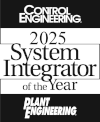
E Tech Group Lead Automation Engineer, Kevin Tom shared his knowledge and expertise on Best Practices for Effective Automation Applications for Control Engineering Magazine‘s webcast on August 16th, 2022, where he discussed the nuances of control system applications.
When Should a Process be Automated?
Kevin explains the criteria that a company should consider when weighing whether or not to apply automation to a process:
- What is being made and how is it currently being produced? Consider tools, parts, mechanisms.
- What is the environment like? Consider space constraints, equipment, hazards.
- What is the labor pool like? Consider union/non-union, labor shortages, turnover.
In considering automation, goals and constraints must also be hashed out:
- Are we trying to replace human labor with mechanized processes?
- Are we trying to scale up operations/increase throughput?
- What is the capital we have to/are willing to invest in this project and what is the necessary ROI?
These questions are all addressed early on in a project’s inception, as stakeholders hold the keys to the budget needed for an automation project. However, control system engineers should also be consulted early on to give insight into the specifics of these questions, like cost, ROI, improvement caps.
Applying Automation is as Much Planning as Execution
Kevin Tom’s cohost points out that much of the time, the options are: automate or die. It may sound histrionic, but the labor shortage is a real and pervasive issue, especially when manufacturers are trying to scale. Increased production goals means hire more people. But there aren’t enough people to be found, and/or high turnover, and/or lack of qualified professionals, which all present labor bottlenecks.
Automation is the best (and only) solution to avoiding the obstacles associated with labor shortages. However, it isn’t as simple as design-build-implement. For the transition to automation to run smoothly, the system first needs to be analyzed and verified virtually. This is another reason control system integrators should be involved in all steps of the process.
As Kevin explained in the webcast, a detailed and well-visualized process design can reveal blind spots otherwise undetectable. This will, in turn, affect the process design, but needs a set of expert eyes to understand how to properly navigate that. This avoids schedule delays and the costs of problems with the implementation, namely, downtime.
Automation Helps, Not Hurts, Human Capital
A key closing point in the webcast was the often overlooked benefits of automation. While the public may perceive robots as replacing people by reducing job positions and opportunities, control system engineers see it a different way: automation actually serves to free up human labor for skilled and complex tasks.
When a facility automates repetitive processes like sorting, counting, packaging, or palletizing, it reduces costs associated with human error, sure. But it also frees up human capital, which can do all the intuitive and complex things that robots can’t. That means more labor available for skilled jobs; more people have the opportunity to occupy positions that require ingenuity, critical thinking and creativity. Want more from Kevin’s talk on best practices for applying automation? Check out this transcript of the live Q&A from the webcast. And to learn more about E Tech Group’s capabilities in building automation, visit our Building Automation page.
